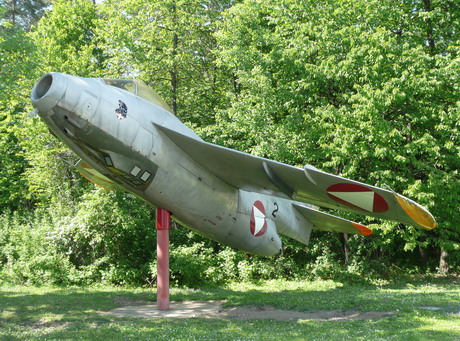Let me introduce you one of my favoruite aircraft!
The J-29 was a sweedish fighter designed and manufactured by Saab in the 1950s. It was called "tunnan" that means "barrel".
The test pilot described the aircraft as "on the ground an ugly duckling – in the air, a swift."
 Design:
Design:The original prototype (R1001) was designed around a mostly straight wing, but after the Swedish engineers had obtained some German research data on swept-wing designs, the prototype was altered to incorporate a 25 degree sweep, first tested on a modified Saab Safir (designated Saab 201). A member of the Saab engineering team had been allowed to review German aeronautical documents stored in Switzerland. These files captured by the Americans in 1945 clearly indicated delta and swept-wing designs had the effect of "reducing drag dramatically as the aircraft approached the sound barrier." [1] The SAAB 29 prototype flew for the first time on 1 September 1948. It was a small, chubby aircraft with a single central air intake, a bubble cockpit and a very thin swept-back wing.
The cannon were mounted under the nose section. There was the landing lights in front of the front gear. The wings angle was 25°.
 Operational history:
Operational history:The J 29 was one of the first production fighters with a swept-back wing. It was fast and agile. The Tunnan set the world speed record on a 500 km (310 mi) closed circuit in 1954[2] at 977 km/h (607.05 mph). Two S 29C (reconnaissance variant) additionally set an international speed record of 900.6 km/h (559.4 mph) over a 1,000 km (620 mi) closed-circuit course in 1955.[2] In the 1950s, the Swedish Air Force, Flygvapnet, primarily using the J 29, was ranked as the fifth most powerful air force in the world, after USA, USSR, UK and France.
The crash record in early service was poor, mainly due to the inexperience with swept-winged aircraft and the lack of a two seat, dual control Tunnan trainer variant: this meant that SAF fighter pilots could only be trained using two seat variants of the de Havilland Vampire (a straight-winged jet), before going solo in a Tunnan.
The fighter version was retired from active service in 1965, but some aircraft were used for target towing up to 1974. The last official military flight was completed in August 1976 at the 50th anniversary air show of the Swedish Air Force.
A total of 30 Tunnans were sold to Austria in 1961 where they remained in service until 1972.
 Tunnan's African war service
Tunnan's African war serviceThe Tunnan was the first Swedish jet aircraft to fight in combat. In 1961, five J 29Bs were stationed in the Democratic Republic of the Congo for a UN peacekeeping mission (ONUC), organized as the F 22 Wing of the Swedish Air Force. It was reinforced by four J 29B and two S 29C (the photo reconnaissance version) in 1962. Most of the missions involved attacking ground targets with internal cannons as well as unguided rockets. No aircraft were lost in action despite large amounts of AAA. Consensus of the crews and foreign observers was that the Tunnan's capabilities were exceptional.[3][4] (Their secessionist adversaries used a few Fouga Magisters and other aircraft with relatively poor air combat capabilities.) The only aircraft lost was by a high-ranking officer who made a trial-run and crashed during an aborted takeoff. When ONUC was terminated in 1964, some of the Swedish aircraft were destroyed at their base, since they were no longer needed at home and the cost of taking them all back was deemed excessive.
Saab J-29 F: General characteristics: Crew: One
General characteristics: Crew: One
Length: 11.0 m (36 ft 1 in)
Wingspan: 10.23 m (33 ft 7 in)
Height: 3.75 m (12 ft 4 in)
Wing area: 24.15 m² (260.0 ft²)
Empty weight: 4,845 kg (10,680 lb)
Max takeoff weight: 8,375 kg (18,465 lb)
Powerplant: 1 × Volvo Aero RM2B turbojet, 6,070 lbf (27 kN)Performance: Maximum speed: 1,060 km/h (660 mph)
Range: 1,100 km (685 mi)
Service ceiling: 15,500 m (50,850 ft)
Rate of climb: 32.1 m/s (6,320 ft/min)
Armament 4x Hispano Mark V 20 mm cannons
75 mm (3 in) unguided rockets
Rb 24 air-to-air missiles
145 mm (5.8 in) anti-armor rockets, 150 mm (6 in) HE (high-explosive) rockets, 180 mm (7.2 in) HE antiship rockets
Variants:J 29 - Four prototypes built in 1949–1950.
J 29A - Fighter, 224 built from 1951 to 1954; later series had wing-mounted dive brakes moved to the fuselage, ahead of the main landing gear doors.
J 29B - Fighter, 332 built 1953–1955; featured 50% larger fuel capacity and underwing hardpoints to carry bombs, rockets and drop-tanks.
A 29B - Same aircraft as the J 29B, but different use.
S 29C - Reconnaissance ("S" was derived from Spaning; either scouting or reconnaissance in Swedish), 76 built from 1954 through 1956; five cameras mounted in a modified nose (no armament was carried). This variant primarily operated at low level and was differentiated by having dark brown and dark green camouflage on the topsides wherein other variants were unpainted.
J 29D - Single prototype to test Ghost RM2A turbojet with 27.5 kN (2,800 kgp / 6,175 lbf) afterburning thrust; project abandoned in 1961.
J 29E - Fighter, 29 built in 1955; incorporated a "dog-tooth" instead of wing slats.
J 29F - Fighter, 308 aircraft converted from available stocks from 1954 to 1956; featured the afterburning Ghost and dog-tooth wing; all remaining aircraft were further modified in 1963 to carry a pair of US-designed AIM-9B Sidewinder heat-seeking air-to-air missiles, built by SAAB under license as the "Rb 24."

So thats all!

Most of the text was copied from wikipedia because my english too pour to wrie a whole article about aircrafts.

I attach some more picture to get a better view of the aircraft:
 The cockpit:
The cockpit: 

 Author
Topic: Saab J-29 "tunnan" (Read 14955 times)
Author
Topic: Saab J-29 "tunnan" (Read 14955 times)


